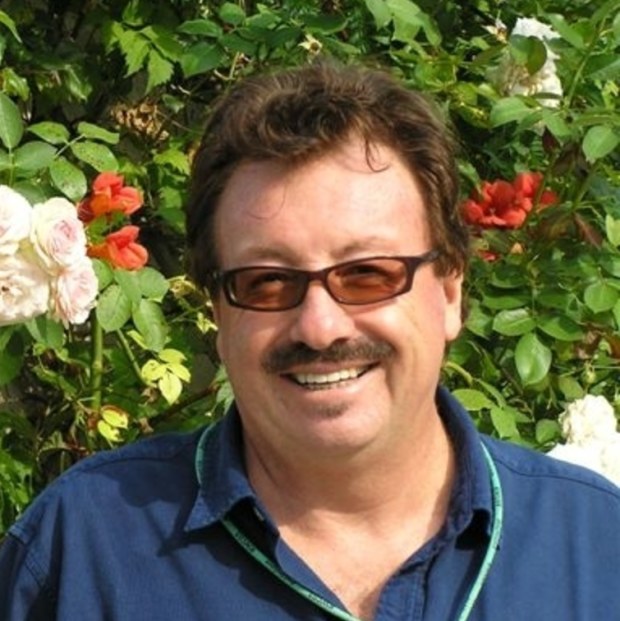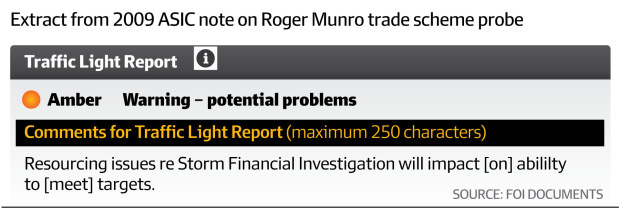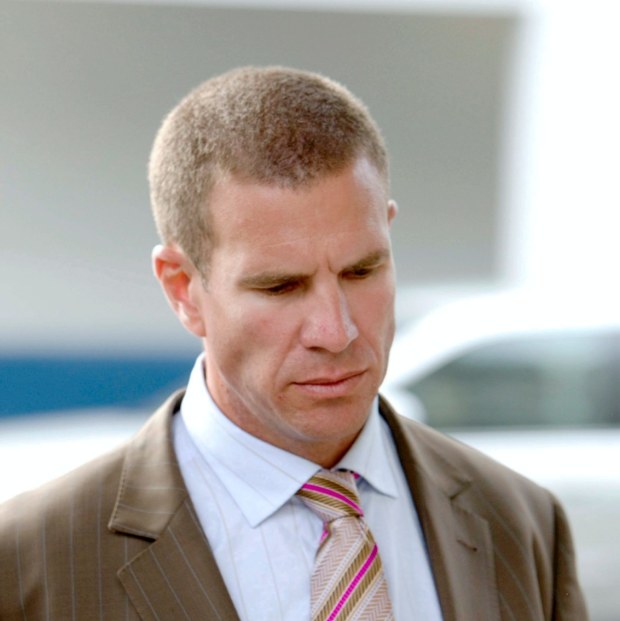Catching a conman (and why it takes so long)
Self-described investment guru Roger Munro has ended up in jail nine years after deceiving clients – and an even longer ASIC pursuit.
Almost three decades before going to jail, Roger Munro was at a luxury restaurant in north Queensland’s tropical resort town of Port Douglas, learning the ropes of trading investment markets.
He was renting a back office amid the palm trees of the Nautilus restaurant and that was hooked up with a 3.7-metre satellite dish. “That was the only way you could get real-time data,” he told Australian Securities and Investments Commission investigators.

Roger Munro, outside the District Court. His conviction casts light on the difficulties in tackling alleged financial wrongdoing. Dan Peled
Munro was a self-starter and a smart man. Dux of his high school in northern NSW’s Casino, he also held a doctorate in econometrics, which uses statistics and quantitative data to create financial theories. He went to “every course” from the ASX and Sydney Futures Exchange to learn to trade, he told investigators, according to a transcript filed in Queensland courts.
Munro even told of paying a programmer $90,000 over nine months to test his doctoral theories – cramming 10 years of sharemarket data to see which variables “yielded the best results”.
On Friday nights, locals who played poker at the restaurant could see Munro at his screen, trading away, and some had their interest piqued. It was a costly introduction into Munro’s investment world.
More than $60 million has vanished since.
It was only last month that Munro was sentenced to 4½ years’ jail time after pleading guilty to fraud around 2013 in a second investment scheme. The amount involved was $299,000.
But his conviction – which he is appealing – casts light on the difficulties, resourcing and the lengthy time taken in tackling alleged financial wrongdoing. That comes with ASIC under new leadership and investors seeking answers to hundreds of millions of dollars in offerings that cratered in the past two years.
Munro for one, always maintained that he never swindled anyone in the original $60 million operation and that the money was still in a US blind trust. He even tried unsuccessfully to reverse his guilty plea to the second smaller scheme.
“I’ve been waiting for four years to fight this tooth and nail. Do you know if I’ll be in contempt if I say what I really think?” he told The Australian Financial Review last year outside Brisbane’s District Court.
Lost savings
Robyn Cannon was in tears. A chunk of savings with partner Frank Grundy was gone. “I certainly kept saying to Frank: ‘I don’t want to do this any more. I’m over it. Let me out of here. Give me a gun’,” Cannon told the Financial Review this month.

Robyn Cannon and Frank Grundy, who lost money in Roger Munro’s schemes. Brian Cassey
She and Frank, both aged 80 and living in Cairns, are now more at peace, albeit with their lifestyle culled. They had met Munro via the restaurant, investing more than $1.4 million earned on ventures such as charter boating. They had introduced friends to his operation. After all, until the global financial crisis, life had seemed great with Munro making quarterly payments.
Other investors were introduced by accountants. One investor recalled that when asking for documents to demonstrate the spectacular results, Munro had refused and insinuated that questioning his ability was out of line. At a later meeting at the Gold Coast, where Munro had relocated, he showed graphics on a laptop and spoke of exponential moving averages and trading velocities. The investor later admitted that the terms meant little to him.
The pitch was that Munro’s computer-based system would make money by trading investments from European currencies to US Treasury bonds and Australian equities.
“Comments … from the former Federal Reserve chairman Alan Greenspan about the possibility of a US recession later this year and the Chinese government announcing a crackdown on new share issues caused the equity, bond and currency markets to hyper-ventilate,” said a quarterly update from 2007. That quarter’s return was 3.31 per cent.
More than 65 investors participated, some from the US. Munro told ASIC that overall, he made “big money” when trading.
Then the global financial crisis hit. Several New York investors tried to redeem funds worth $22 million. Munro claimed that a dispute arose about equitably distributing the money, sparking legal action. Liquidators were appointed to his US and Australian trading entities.
Once a friendly guy with a toothy grin, who would send Christmas cards to investors and adored his mother, Munro portrayed himself as wrecked.
“I have been in psych care … with enough medication to sink an elephant,” he told investors.
Problems emerge
In the fallout, one liquidator, Tim Michael, now with KPMG, wrote in an affidavit about “serious concern the company never in fact generated the returns to investors that are represented in the quarterly reports”.
Another entity’s liquidator, Mark Pearce of Pearce and Heers, detailed in an affidavit a startling records system. Munro’s primary record-keeping method was one red ledger book and ring-binder datebook. They contained “handwritten notes which Dr Munro stated were his [quarterly] calculations of the returns”, Pearce said.

Roger Munro in his younger days.
Further questions surfaced. Munro maintained that he believed investor funds of $US62 million were in a Utah bank account. But ASIC could not find anything to show the money had been transferred there. “That’s a surprise,” Munro told the ASIC officers in July 2009.
If the funds were not in the bank, Munro surmised that they would have been held by another entity that had done an arms-length deal with his company, allowing investors to redeem funds later.
An ASIC investigator kept up the grilling: “Have you lost all of the … trading funds through trading?”
“No,” Munro replied.
Some within ASIC were suspicious. A legal specialist, in an email obtained via freedom of information laws, sent a briefing on “what appears to be a Ponzi scheme”. The scheme, “like Madoff” – a reference to notorious US fraudster Bernie Madoff – had “unravelled when redemption requests could not be met”.
But ASIC was straining. An investigation progress report in June 2009 was flagged “amber” under its internal traffic light system. “Resourcing issues re Storm Financial Investigation will impact … meeting targets,” it said.

An ASIC market analyst was asked internally to help audit statements, send notices to brokers and analyse the movements of money, stocks, margins and collateral. It would take three weeks. “I am currently not in a position to provide assistance,” the analyst wrote, citing the current workload.
ASIC pressed ahead. Twice it sent briefs to the Commonwealth Director of Public Prosecutions but these were rejected. The prosecutors determined that there were “no reasonable prospects of convictions being secured”, an ASIC manager told investors in 2011.
Munro was off the hook. Then he tripped up.
New venture
That same year, he emailed people about a new “Tradestation” venture. Astonishingly, that included earlier investors who were still owed funds, which Munro was vowing would be returned.
Investors even received emails from a US attorney supposedly involved with the funds. Some now question those messages, and in court, Munro accepted that he had told an Australian lawyer of writing “an email purporting to come from [the] American attorney” and sending this to investors.
Cannon backed Munro again in the new venture. She believed the earlier money would be returned and Munro was a good trader.
“In hindsight – my god, how stupid. It was a Ponzi scheme,” she said. (Justice Paul Smith’s judgment this year determined that Munro’s latest venture “clearly had the hallmarks of a Ponzi scheme”.)
More than $1.5 million was raised from investors, including friends. But ASIC was watching again after a tip-off in 2014.
Munro was unimpressed by the latest meddling and stormed out during a grilling at ASIC’s Brisbane office in 2015.
“I’ve finished. I don’t give a stuff what you’re doing here,” he told an investigator, according to a court-filed transcript. “You’ve reached your use-by date, old boy. You take any action you want to from here on in. Write to my lawyer, if I can find the money to pay him.”
By 2017, Munro was broke and under pressure. His bankruptcy filing listed miserable assets: $132 in the bank and three “fake” watches worth less than $100.
ASIC’s civil action mounted, which Munro lost. Finally, criminal charges were filed in 2017. Lengthy adjournments ensued because of reasons ranging from medical issues to the pandemic.
Then, after finally pleading guilty last year, Munro tried reversing his plea, but to no avail. The judge found that Munro simply “regretted his decision”.
Smith’s judgment detailed the wrongdoing, including how Munro’s new trading account generally operated at a loss and did not generate the profits “claimed by [Munro] in his quarterly email reports to investors”.
Four charges had related to $710,000 involving several investors, although prosecutors progressed only three charges. One charge for almost $411,000 – Cannon’s money – was dropped. She could not continue with the trial as she had needed cancer treatment.
She now reflects on what went wrong. “It’s amazing how vulnerable we all are, I guess. Is it greed? I don’t know what it is. You just get caught up in something when they’re that good,” she says.
Munro was in shambles on the day of sentencing. Shirt untucked, swaying constantly in the dock, the 72-year-old was told he would be eligible for parole in 15 months. A family member hugged him goodbye.
He joined a list of financial scoundrels: former Rich Lister Craig Gore, found guilty in 2020 for defrauding investors in 2013; and ex-Billabong chief executive Matthew Perrin, jailed in 2016for deceiving Commonwealth Bank in 2008.
Why do such cases take so long? The collaboration and finding the resources can pose problems, say sources with experience in investigating financial crimes across the private and public sectors. The process of investigating and prosecuting matters also contains many hurdles.

Former Billabong boss Matthew Perrin. Glenn Hunt
“The standard of proof is very, very high,” says Craig Allsopp, a practice leader at Shine Lawyers and a former ASIC senior lawyer.
Michel Picard of the Royal Canadian Mounted Police wrote in a 2008 paper in the Journal of Financial Crime that investigations were lengthy because of “a complex process from the time a complaint is received to the day charges are laid”.
“It cannot be otherwise considering the complexity of most frauds and the necessity of gathering a multidisciplinary team of experts to cover all aspects.”
Some suspects, who might be innocent, might also hire top-shelf lawyers and the cases against them are found to be weak.
Obtaining evidence can be time-consuming – records might not exist and tracing money flows could require multiple communications with institutions. One bank account might lead to another, for instance. Sometimes overseas agency cooperation is required. All this must be done under black-letter law to prevent evidence from being tainted.
Some victims might initially feel reluctant to help as witnesses. Perhaps they don’t want to accept that they’ve been suckered or possibly, they’re scared.
Also, Ponzi schemes can be particularly hard to detect if the promoters ensure they do not attract regulatory attention.
“They keep their operations small in terms of human resources,” University of Michigan-Flint academics Surendranath Jory and Mark Perty wrote in a 2011 paper in the Journal of Financial Planning.
“Second, Ponzi promoters publish little information about their operations. This lack of information makes it hard to uncover their fraudulent activities.”
ASIC told the Financial Review that it would mount action against Ponzi schemes and had the resources and expertise to prosecute people who were manipulating investors.
But it added the adage: “If an investment seems too good to be true, it probably is.”
Back in Cairns, Cannon praises the ASIC investigators who worked the case over the years. However, she criticises the overall justice system. “It took so long,” she says.
Trevor King, a former farmer who developed Byron Bay land and lost $31 million in Munro’s original scheme, remains unimpressed.
ASIC was the “biggest arsehole of a government agency ever invented”, he says. “ASIC has to improve its ability to do what it says it will do.”


